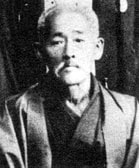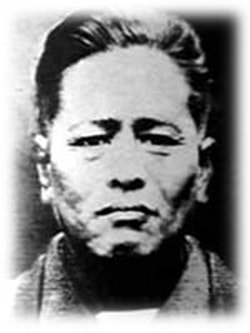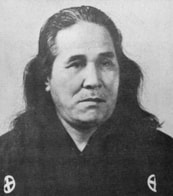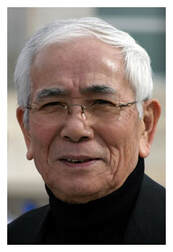
Goju Ryu Karate is one of the oldest martial arts traditions and movements. The system is based on the concept of hard (go) and soft (ju). The internal, soft style concentrates on circular movements and the development of chi (vital energy), while external, hard (go) principle relies upon physical strength. The combination gives Goju Ryu its beauty, disciplined movements, grace, and flowing forms. Goju Ryu is a close-range, infighting system that concentrates on efficiency of movements.
Primary characteristics of Goju-Ryu:
Primary characteristics of Goju-Ryu:
- Goju Ryu carries characteristics of a Bujutsu including grappling and throwing techniques as well quick and explosive motions generated from the hips.
- Jiyu-Kumite (free sparring) was developed for close range fighting utilizing Neko Ashi Dachi (cat stance or cat leg stance) to quickly and easily move to and from other body positions for a more effective fighter.
- Circular movements

Grandmaster Kanryo Higaonna was born on March 10, 1853, in Naha, the capital city of Okinawa. His father, Kanyo, worked as a merchant sailing between the small islands of Okinawa trading everyday goods. From a young age Kanryo Higaonna helped his father in this work and through the hard physical labor that was involved he developed a strong body.
Kanryo decided he wanted to study the martial arts and he set his heart on traveling to China for this purpose. He arrived in 1869, at the age of 16. He studied the Chinese martial arts under the great Master, Ryu Ryu Ko. He soon became “uchi deshi” (private disciple) and he remained in China under the instruction of his teacher for approximately 13 years. In addition to studying empty handed martial arts he also became accomplished in weapons techniques and Chinese herbal medicine.
In the year 1881, after 13 years of diligent study with his teacher he returned to Okinawa, and Naha where his martial arts became known as Naha-te. Kanryo Higaonna taught these martial arts to the people of Okinawa and at the same time continued his own research and practice. In order to teach the youth of Okinawa he developed a teaching method which was specifically designed to develop the mind and body; to improve both physical and spiritual well-being.
The first occasion on which the previously secretive art of Naha-te was “opened” to society in general, occurred in October 1905, when Kanryo Higaonna began teaching at the Naha Commercial High School.
When teaching, Kanryo Higaonna was an extremely hard task master. However, in his everyday life he was a quiet and humble man and one who was renowned for his virtuous character. He was a man who had no need or desire for worldly things. He lead a simple life which was completely devoted to the study and practice of the martial arts.
Kanryo decided he wanted to study the martial arts and he set his heart on traveling to China for this purpose. He arrived in 1869, at the age of 16. He studied the Chinese martial arts under the great Master, Ryu Ryu Ko. He soon became “uchi deshi” (private disciple) and he remained in China under the instruction of his teacher for approximately 13 years. In addition to studying empty handed martial arts he also became accomplished in weapons techniques and Chinese herbal medicine.
In the year 1881, after 13 years of diligent study with his teacher he returned to Okinawa, and Naha where his martial arts became known as Naha-te. Kanryo Higaonna taught these martial arts to the people of Okinawa and at the same time continued his own research and practice. In order to teach the youth of Okinawa he developed a teaching method which was specifically designed to develop the mind and body; to improve both physical and spiritual well-being.
The first occasion on which the previously secretive art of Naha-te was “opened” to society in general, occurred in October 1905, when Kanryo Higaonna began teaching at the Naha Commercial High School.
When teaching, Kanryo Higaonna was an extremely hard task master. However, in his everyday life he was a quiet and humble man and one who was renowned for his virtuous character. He was a man who had no need or desire for worldly things. He lead a simple life which was completely devoted to the study and practice of the martial arts.

Grandmaster Chojun Miyagi was born on April 25, 1888. He began his Karate training in Shuri-te and at the age of 14 was introduced to Kanryo Higaonna with whom he began his study of Naha-te. Like his teacher before him, because of his great natural talent and fierce determination, he progressed very rapidly. The training was severe beyond belief at times but he practiced ever harder with an enthusiasm unmatched by any of the other students. Chojun Miyagi became "uchi deshi" (private discipline) of Kanryo Higaonna. He studied with his teacher for 14 years before his teacher's death in 1915.
Chojun Miyagi, as successor to his teacher's "te", pushed himself to the limits of endurance in his desire to emulate his teacher's extraordinary skill. In 1915 he journeyed to China, the city where his teacher had studied martial arts to further his research. This was one of three trips he made to China during his lifetime.
On his return to Okinawa he began to teach the martial arts out of his home in Naha. Later, he also taught at the Okinawan Prefecture Police Training Center, at the Okinawan Master's Training College, and at the Naha Commercial High School (where his teacher had once taught).
Chojun Miyagi worked hard to spread Karate throughout Okinawa and mainland Japan. In 1933, Goju-Ryu Karate was the first Okinawan martial art to be registered at the Dai Nippon Butoku-Kai, the center for all martial arts in Japan. This was a milestone for Karate as it meant it was recognized on a level with the highly respected martial arts of Japan.
The naming of Goju-Ryu came about more by accident than by design. In 1930, Chojun Miyagi's top student, Jin'an Shinzato, while in Tokyo demonstrating the Karate of his teacher, was asked as to what school of martial arts he practiced. As Naha-te had no formal name he could not answer this question. On his return to Okinawa he reported this incident to Chojun Miyagi. After much consideration, Chojun Miyagi chose the name Goju-Ryu (hard and soft school) as a name for his style. This name he took from a line in the "Bubishi" (a classical text on martial arts and other subjects). This line, which appears in a poem describing the eight precepts of the martial arts reads, "Ho Wa Go Ju O Don To Su" (the way of breathing is hardness and softness).
Chojun Miyagi, as successor to his teacher's "te", pushed himself to the limits of endurance in his desire to emulate his teacher's extraordinary skill. In 1915 he journeyed to China, the city where his teacher had studied martial arts to further his research. This was one of three trips he made to China during his lifetime.
On his return to Okinawa he began to teach the martial arts out of his home in Naha. Later, he also taught at the Okinawan Prefecture Police Training Center, at the Okinawan Master's Training College, and at the Naha Commercial High School (where his teacher had once taught).
Chojun Miyagi worked hard to spread Karate throughout Okinawa and mainland Japan. In 1933, Goju-Ryu Karate was the first Okinawan martial art to be registered at the Dai Nippon Butoku-Kai, the center for all martial arts in Japan. This was a milestone for Karate as it meant it was recognized on a level with the highly respected martial arts of Japan.
The naming of Goju-Ryu came about more by accident than by design. In 1930, Chojun Miyagi's top student, Jin'an Shinzato, while in Tokyo demonstrating the Karate of his teacher, was asked as to what school of martial arts he practiced. As Naha-te had no formal name he could not answer this question. On his return to Okinawa he reported this incident to Chojun Miyagi. After much consideration, Chojun Miyagi chose the name Goju-Ryu (hard and soft school) as a name for his style. This name he took from a line in the "Bubishi" (a classical text on martial arts and other subjects). This line, which appears in a poem describing the eight precepts of the martial arts reads, "Ho Wa Go Ju O Don To Su" (the way of breathing is hardness and softness).

Gogen Yamaguchi was born on January 20th, 1909 with the name Jitsumi in the city of Kagoshima on the southern end of Kyushu, Japan. His father was Tokutaro Yamaguchi. When Gogen Yamaguchi was young, he already showed a great interests in martial arts.
After his family moved to Kyoto, he began the serious study of Karate with Takeo Maruyama at the Maruta Dojo in Miyazai Kyushu. Maruta Sensei, who was a Goju practitioner was drawn to the young Yamaguchi’ s serious attitude and his willingness to train hard. Therefore, Maruta Sensei taught Yamaguchi all he knew about the Goju system.
In 1928, he studied Law at Kansei University. From 1929 to 1937, he studied at Ritsumeikan University and received Law degrees. He started a Karate club and invented its free sparring form while studying at the University. At that time, all Karate schools in Okinawa and Japan practiced Kata and pre-arranged application exercise and never attempted to practice free form sparring.
In 1937, he received the name Gogen from Chojun Miyagi who authorized him to promote the school of Goju-Ryu Karate in Japan. In 1950, he founded the national organization of All-Japan Karatedo Goju-Kai in Tokyo, Japan.
Gogen Yamaguchi has developed what we called "modern Karate". From a technical point of view, he had unified all Karate exercise by employing an extremely well organized method. As a result of the introduction of free-style sparring, the art of Karate had became a more active and popular art in Japan as well as in other parts of the world.
After his family moved to Kyoto, he began the serious study of Karate with Takeo Maruyama at the Maruta Dojo in Miyazai Kyushu. Maruta Sensei, who was a Goju practitioner was drawn to the young Yamaguchi’ s serious attitude and his willingness to train hard. Therefore, Maruta Sensei taught Yamaguchi all he knew about the Goju system.
In 1928, he studied Law at Kansei University. From 1929 to 1937, he studied at Ritsumeikan University and received Law degrees. He started a Karate club and invented its free sparring form while studying at the University. At that time, all Karate schools in Okinawa and Japan practiced Kata and pre-arranged application exercise and never attempted to practice free form sparring.
In 1937, he received the name Gogen from Chojun Miyagi who authorized him to promote the school of Goju-Ryu Karate in Japan. In 1950, he founded the national organization of All-Japan Karatedo Goju-Kai in Tokyo, Japan.
Gogen Yamaguchi has developed what we called "modern Karate". From a technical point of view, he had unified all Karate exercise by employing an extremely well organized method. As a result of the introduction of free-style sparring, the art of Karate had became a more active and popular art in Japan as well as in other parts of the world.

Born in Tokyo, Hanshi Shuji Tasaki was one of the Head Shihan in the early years of the All Japan Karate do Goju Kai. In 1971 Hanshi Shuji Tasaki founded Goju Ryu Karate do Seiwa Kai.
1933 – January 20th – Born in Tokyo, Japan.
1950 – Begins Karate training in High School.
1952 – Joins the Yamaguchi’s Asakusa ‘All Japan Karate do Goju Kai’ Goju Ryu Dojo.
1958 – Grades to Sandan in Yamaguchi Goju Kai Goju Ryu Karate do.
1961 – Grades 4th Dan and Jokyo Renshi license issued by Yamaguchi Goju Kai.
1964 – Shihan license issued by Yamaguchi Goju Kai.
1965 – Grades to 5th Dan in Yamaguchi Goju Kai Goju Ryu Karate do.
1970 – Grades to 6th Dan JKF Goju Kai, Kysoshi
1971 – Founds Seiwa Kai JKF Goju Kai] Goju Ryu Karate do.
1974 – Appointed JKF National Instructor.
1975 – Grades to 7th Dan, JKF Goju Kai.
1986 – Acquired the grade JKF Goju Kai 8th Dan.
1986 – Acquires the Shihan license of Hanshi.
2008 - JKF 9th Dan
He actively served as Goju Kai Deputy Chief of Board of Directors, Central Examiner and Manager of the Kanto Region.
1933 – January 20th – Born in Tokyo, Japan.
1950 – Begins Karate training in High School.
1952 – Joins the Yamaguchi’s Asakusa ‘All Japan Karate do Goju Kai’ Goju Ryu Dojo.
1958 – Grades to Sandan in Yamaguchi Goju Kai Goju Ryu Karate do.
1961 – Grades 4th Dan and Jokyo Renshi license issued by Yamaguchi Goju Kai.
1964 – Shihan license issued by Yamaguchi Goju Kai.
1965 – Grades to 5th Dan in Yamaguchi Goju Kai Goju Ryu Karate do.
1970 – Grades to 6th Dan JKF Goju Kai, Kysoshi
1971 – Founds Seiwa Kai JKF Goju Kai] Goju Ryu Karate do.
1974 – Appointed JKF National Instructor.
1975 – Grades to 7th Dan, JKF Goju Kai.
1986 – Acquired the grade JKF Goju Kai 8th Dan.
1986 – Acquires the Shihan license of Hanshi.
2008 - JKF 9th Dan
He actively served as Goju Kai Deputy Chief of Board of Directors, Central Examiner and Manager of the Kanto Region.